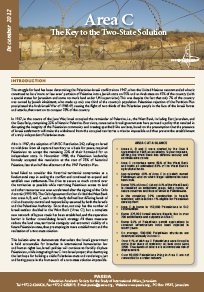Area C The Key to the Two-State Solution
Overview
The struggle for land has been determining the Palestinian-Israeli conflict since 1947, when the United Nations recommended what it construed to be a ‘more or less even’ partition of Palestine into a Jewish state on 55% and an Arab state on 45% of the country (with a special status for Jerusalem and some no-man’s land under UN supervision). This was despite the fact that only 7% of the country was owned by Jewish inhabitants, who made up only one third of the country’s population.Palestinian rejection of the Partition Plan precipitated the Arab-Israeli War of 1948-49, causing the flight of two-thirds of the Palestinian people in the face of the Israeli forces and attacks, that went on to conquer 78% of the country. In 1967, in the course of the June War, Israel occupied the remainder of Palestine, i.e., the West Bank, including East Jerusalem, and the Gaza Strip, comprising 22% of historic Palestine. Ever since, consecutive Israeli governments have pursued a policy that resulted in disrupting the integrity of the Palestinian community and creating apartheid-like enclaves, based on the presumption that the presence of Israeli settlements will make the withdrawal from the occupied territories a mission impossible and thus prevent the establishment of a truly independent Palestinian state. Also in 1967, the adoption of UNSC Resolution 242, calling on Israel to withdraw from all captured territory as a basis for peace, required Palestinians to accept the remaining 22% of their homeland for an independent state. In November 1988, the Palestinian leadership formally accepted this resolution at the cost of 78% of historical Palestine, less than half the allotment of the 1947 Partition Plan. Israel failed to consider this historical territorial compromise as a fundamental step in ending the conflict and continued to expand and establish new settlements. The drive to secure as much control over the territories as possible while restricting Palestinian access to land and other resources was even accelerated after the signing of the Oslo Accords (1993-95). The Oslo Agreement further divided the West Bank into areas A, B, and C, each with clearly defined but differing levels of
civil and security control and responsibility assumed by both the Israelis and the Palestinian Authority. Since then, not only has the number of Israeli settlers doubled in the West Bank (‘Area C’), but a complete new network of bypass roads has been established, and the separation barrier is further consolidating Israel’s strategy. All these measures reduce the land area, territorial contiguity and economic viability of a future Palestinian state, thus preempting its mere establishment and the realization of a two-state solution. This bulletin aims to demonstrate that unless the Israeli government is held accountable for breaches in international humanitarian law and human rights law, Israeli policies will continue to forcibly displace Palestinians, while integrating Area C into Israel proper, thus destroying the last hope for building a viable Palestinian state and rendering a just
and lasting peace in the framework of a two-state solution impossible.

